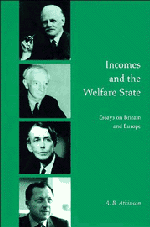Book contents
- Frontmatter
- Contents
- List of figures
- List of tables
- Preface
- Introduction
- I Income inequality and poverty in Britain and Europe
- 1 What is happening to the distribution of income in the UK?
- 2 Income distribution in European countries
- 3 Poverty, statistics and progress in Europe
- 4 Comparing poverty rates internationally: recent studies in OECD countries
- 5 Two nations in early retirement? The case of Britain
- II Analysis of the Welfare State
- III Targeting and the future of social security policy
- Notes
- Bibliography
- Name index
- Subject index
4 - Comparing poverty rates internationally: recent studies in OECD countries
Published online by Cambridge University Press: 03 May 2011
- Frontmatter
- Contents
- List of figures
- List of tables
- Preface
- Introduction
- I Income inequality and poverty in Britain and Europe
- 1 What is happening to the distribution of income in the UK?
- 2 Income distribution in European countries
- 3 Poverty, statistics and progress in Europe
- 4 Comparing poverty rates internationally: recent studies in OECD countries
- 5 Two nations in early retirement? The case of Britain
- II Analysis of the Welfare State
- III Targeting and the future of social security policy
- Notes
- Bibliography
- Name index
- Subject index
Summary
The World Development Report 1990 (World Bank, 1990) estimates that a third of the population of the developing world had incomes below US$370 a head in 1985, but that the proportion varied from about half in Sub-Saharan Africa and South Asia to a fifth in East Asia and Latin America. Investigating the reasons for such differences is an obvious first resort in evaluating the success of different policies in reducing poverty, and in identifying priorities. To take a second example, estimates produced for the European Commission show the proportions in different member countries with incomes below 50 per cent of the national average (O'Higgins and Jenkins, 1989; see chapter 3): such figures may be used to draw conclusions about the relative effectiveness of, for instance, the minimum wage policy in France as against the extensive social assistance network of the United Kingdom. Equally important, poverty statistics for different countries may be the basis for allocating investment and readjustment funds by supranational bodies such as the European Community.
If international comparisons of poverty are to be used in this way, it is vital to identify and examine the concepts on which they are based; the objective of this chapter is to provide a selective review of the principal issues involved, complementing that provided in chapter 3. The illustrations are from countries that belong to the Organisation for Economic Cooperation and Development (OECD).
- Type
- Chapter
- Information
- Incomes and the Welfare StateEssays on Britain and Europe, pp. 78 - 94Publisher: Cambridge University PressPrint publication year: 1996



